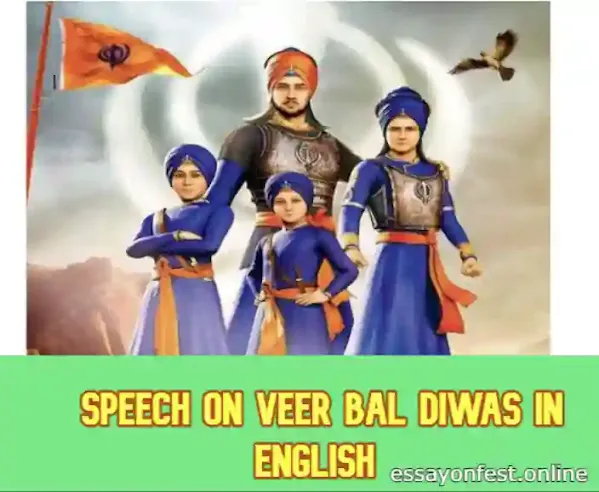Speech On Veer Bal Diwas In English
Ladies and gentlemen,
Today, we gather to remember and honor a chapter in Sikh history that is both somber and profoundly inspiring. The history of the Sikhs and Punjab is incomplete without paying homage to the sacrifice of the four ‘Sahibzadas,’ the younger sons of Guru Gobind Singh, the tenth Sikh Guru.
The term 'Sikh,' rooted in the Sanskrit word 'Shishya,' meaning 'learner' or 'disciple,' reflects the essence of the Sikh community. The Sikhs follow the teachings of their revered gurus, from Guru Nanak Dev Ji to Guru Gobind Singh Ji. Guru Nanak Dev Ji laid the foundation for a more inclusive and egalitarian society by rejecting social divisions and inequalities perpetuated by the caste system.
Guru Gobind Singh, known as the Saint-Soldier, carried forward this spiritual light and embraced a martial tradition. His vision was to create a community of fearless and selfless individuals, embodied in the formation of the Khalsa – the 'pure.' However, this vision brought him into conflict with the rulers of the time who perceived him as a threat to their authority.
The Battle of Chamkaur on December 7, 1705, stands as a testament to the unwavering courage and sacrifice of Guru Gobind Singh's sons and his loyal followers. Faced with overwhelming odds, they defended a mud-walled fortress against a massive army. The battle claimed the lives of many, including the Guru's sons Ajit Singh and Jujhar Singh, who begged for the honor of facing certain death.
The subsequent events, including the betrayal by Gangu and the martyrdom of Guru Gobind Singh's younger sons Zorawar Singh and Fateh Singh, highlight the unimaginable challenges faced by the Guru's family.
To commemorate the unparalleled martyrdom of the Sahibzadas, December 26 is celebrated as “Veer Bal Diwas” – a day to pay tribute to their sacrifice. The resilience and unshakeable faith displayed by these young heroes serve as a poignant and morally uplifting reminder for all of us.
In conclusion, let us remember and reflect upon the sacrifices made by the Sahibzadas, whose courage and devotion continue to inspire generations. As we pay homage to them, let us strive to embody the spirit of selflessness, equality, and courage in our own lives.
“Waheguru ji ka Khalsa, Waheguru ji ki Fateh.”
Also read: Sisu divas odia Bhasana | Children's day odia speech
Also read: Speech Children's Day in Bengali for Students and Children's
Also read: Speech On International Students Day In English
Also read: பாரதியார் பற்றிய பேச்சு போட்டி
THANK YOU SO MUCH

The consistency in delivering quality content speaks volumes about your dedication. A reliable source of valuable information!
ReplyDeleteDive into the digital realm where conversations spark like virtual fireworks. Online chat https://camtify.com/ opens doors to new friendships, connecting people across distances with just a click. Share thoughts, laughter, and stories in the boundless world of the internet.
ReplyDeleteHello, friends! I would like to recommend you this site where you can play the best slot machines on different themes - wolfwinner1 . This is simply the best site where I played slot machines, because here I found a large number of slots and different online roulettes. You should definitely try this site.
ReplyDeleteOlá amigos. O artigo no sítio Web do ecbahia apresenta uma descrição pormenorizada e interessante do Como o Campeonato Brasileiro resolve o problema da constante saída de talentos? . O autor demonstra de forma convincente que o regresso de jogadores famosos ao seu país de origem após as suas carreiras europeias aumenta o nível de competição e atrai a atenção para a liga. É também sublinhado que o investimento das receitas das transferências de jovens jogadores em novos talentos cria um sistema de desenvolvimento sustentável. Óptima análise do problema e das soluções!
ReplyDeleteThis comment has been removed by the author.
ReplyDeleteI can't say enough good things about [url=https://savetiktok.org/]Savetiktok[/url]. It's incredibly easy to use, and the videos come out in perfect quality without any watermarks. The speed of the downloads is impressive, and I've never encountered any issues with the service. It's by far the best tool I've found for downloading TikTok videos. A must-have for any TikTok fan!
ReplyDeleteI can't say enough good things about https://savetiktok.org/ It's incredibly easy to use, and the videos come out in perfect quality without any watermarks. The speed of the downloads is impressive, and I've never encountered any issues with the service. It's by far the best tool I've found for downloading TikTok videos. A must-have for any TikTok fan!
ReplyDelete